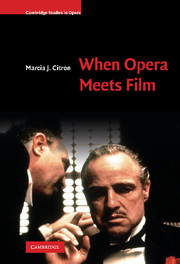Book contents
- Frontmatter
- Contents
- List of figures
- List of tables
- List of music examples
- Acknowledgments
- Introduction
- Part I Style
- Part II Subjectivity
- 3 Subjectivity in the opera-films of Jean-Pierre Ponnelle
- 4 Don Giovanni and subjectivity in Claude Chabrol's La Cérémonie
- Part III Desire
- Epilogue
- Notes
- Bibliography
- Filmography and videography
- Index
3 - Subjectivity in the opera-films of Jean-Pierre Ponnelle
from Part II - Subjectivity
Published online by Cambridge University Press: 04 August 2010
- Frontmatter
- Contents
- List of figures
- List of tables
- List of music examples
- Acknowledgments
- Introduction
- Part I Style
- Part II Subjectivity
- 3 Subjectivity in the opera-films of Jean-Pierre Ponnelle
- 4 Don Giovanni and subjectivity in Claude Chabrol's La Cérémonie
- Part III Desire
- Epilogue
- Notes
- Bibliography
- Filmography and videography
- Index
Summary
Jean-Pierre Ponnelle is one of the most important opera directors of the late twentieth century. From the 1960s through his death in 1988, his work appeared in leading venues across the world, from Salzburg to San Francisco, and he usually served as designer as well as director. Ponnelle's reputation rests on imaginative productions steeped in a thorough knowledge of music, libretto, and cultural context, and an obsessive attention to detail. He was considered a leading interpreter of Mozart, and his twenty-year relationship with the Salzburg Festival led to memorable productions. In addition, his legendary Monteverdi cycle at Zürich in collaboration with Nikolaus Harnoncourt (1975–77) marked a major moment in the revival of early opera.
Extending his operatic reach to the screen, Ponnelle began a fruitful relationship with Unitel, the German media company, and from 1972 to 1988 they collaborated on sixteen opera-films for television. While many are little more than stage productions captured by the camera, for example Il barbiere di Siviglia (1972), several make extensive use of cinematic techniques: Madama Butterfly (1974), Le nozze di Figaro (1976), and Rigoletto (1982). Others, such as Orfeo (1979) and Così fan tutte (1988), feature cinematic touches but remain close to the stage. Although a few use real locations (La clemenza di Tito [1980] and Rigoletto), Ponnelle's work was shot mainly in the studio, a common approach in European televised opera at the time.
Full-length opera-films for cinema blossomed in the late 1970s and 1980s, roughly the heyday of Ponnelle's television films.
- Type
- Chapter
- Information
- When Opera Meets Film , pp. 97 - 135Publisher: Cambridge University PressPrint publication year: 2010



